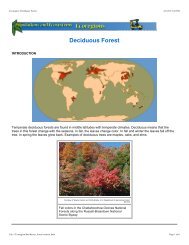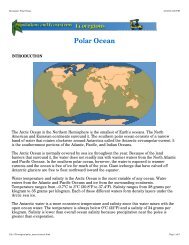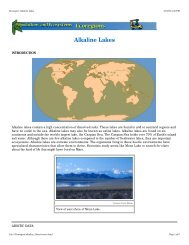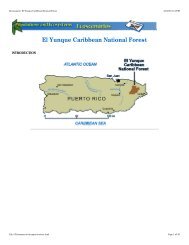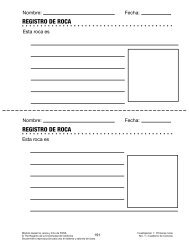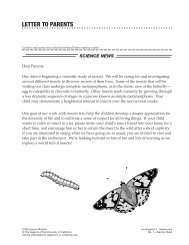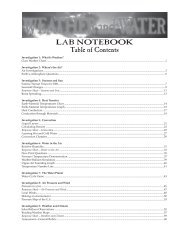Ecoscenarios Combined - FOSSweb
Ecoscenarios Combined - FOSSweb
Ecoscenarios Combined - FOSSweb
You also want an ePaper? Increase the reach of your titles
YUMPU automatically turns print PDFs into web optimized ePapers that Google loves.
Ecoscenario: Delaware Water Gap National Recrational Area<br />
4/16/03 3:11 PM<br />
Why is acid rain such a problem?<br />
An acid is a chemical that in a water solution tastes sour and reacts easily with many other substances. Lemon<br />
juice, vinegar, and hydrochloric acid are acids. Lemon juice and vinegar are dilute acids, and hydrochloric acid is<br />
strong. Acidity is a measurement of how many charged hydrogen ions are in a solution. This is called pH, and it is<br />
measured on a scale of 1 to 14. Solutions with a pH between 1 and 6.9 are acidic, and those between 7.1 and 14<br />
are basic. Liquids with a pH of 7, like pure water, are neutral. There is a tenfold difference between each number on<br />
the scale. So a solution with a pH close to 2, like lemon juice, is ten times more acidic than a solution with a pH 3.<br />
Rainwater is naturally a little bit acidic, pH 5–5.6. Normally, rainwater picks up some minerals as it flows through<br />
the ground to lakes and streams. The pH of a lake or stream depends in part on what rocks and minerals are in the<br />
watershed and the river bottom. Some rocks, like limestone, are basic and neutralize acids. Most healthy lakes and<br />
streams have a pH between 7 and 9.2.<br />
Courtesy of National Atmospheric Deposition Program<br />
This map shows the pH of rain that fell in the United States in 1994.<br />
Acid precipitation, or acid rain, officially has a pH less than 5.6. However, the pH of acid rain can be as low as that<br />
of lemon juice or vinegar. Acid rain may fall directly into a lake or stream, or flow there as runoff from the watershed.<br />
If the lake contains limestone bedrock, the acid is neutralized for a while. However, eventually all the neutralizing<br />
capacity, or buffer, in the bedrock is used up, and the pH of the lake or stream begins to drop. When it receives<br />
acid precipitation, the pH of a lake can drop from 9.2 to below 4.5 in less than 10 years.<br />
file:///Ecoscenario/delgap/content.html<br />
Page 10 of 14



